
There is not such thing as an unlimited mailbox. Managing larger files requires faster computers, which can be expensive.

#How to change outlook ost file location archive
Other files are critical to Outlook's operation and their loss could cause you to have to re-set up your email accounts.Įncourage all staff to archive or delete unneeded items. The OST file is safe to delete.ĭO NOT DELETE ANY OTHER FILES. Once you find the OST file, you can close outlook, and delete the file. Starting in This PC, you can normally find your profile under the C drive. In general, the files will be located in a subfolder of your profile directory. If you received the warning message mentioned above, you may see the location there. To delete something first you have to find it. You should consider selecting a shorter cache timeframe or the very process of completing the caching process could corrupt the file again. When this happens, the only viable option is to delete your OST file and let Outlook rebuild it.

Deleting a few messages won't reduce the size enough, and the file will likely become corrupt as Outlook crashes under the burden. To reduce the amount of data in this file, permanently delete some of the items that you no longer need.Īt that point though you are likely stuck. The Outlook data file C:\User\.ost has reached the maximum size. You will stop receiving email, you may be unable to edit contacts or calendar entries, and you will eventually see a message like: If you do not manage to keep the file size under 50GB, things get "weird". That takes time though, and a lot of bandwidth, and you will suffer lower performance while you do this. If that happens you need to delete the entire file, and Outlook will re-cache it. There are a few benefits - you can keep your OST files smaller, and you can more easily remove accounts and files you no longer need.Īs OST files get larger they are more likely to become corrupt. Each account would have it's own Change option, and you could have more control over how much history you cache of each account. If however you set up multiple accounts within outlook, each OST file is independent. That said, if you access shared or delegated folders, that content is also stored in single OST file. It simply determines how large a local cache to make based on your timeframe.

Keep in mind this does NOT change the size of your mailbox and does NOT archive your mailbox for you.

Options include 3 days, 1 week, 2 weeks, 1 month, 3 months, 6 months, 1 year, 2 years, 3 years, 5 years, and All.
#How to change outlook ost file location Offline
To improve performance as you navigate between messages, Outlook supports "cached mode". That way you can read / respond to messages offline or work efficiently with little or no Internet service. When you connect to Microsoft Exchange (Office 365), you normally want to be able to tolerate Internet congestion or a complete loss of Internet service.


 0 kommentar(er)
0 kommentar(er)
